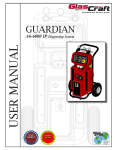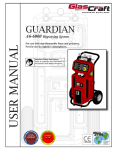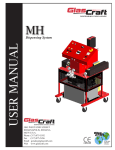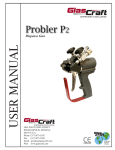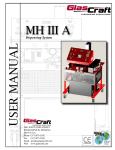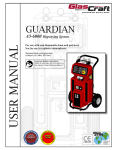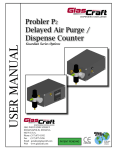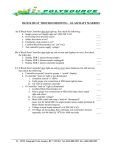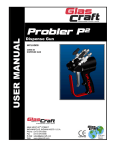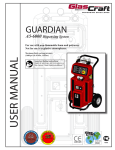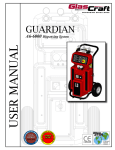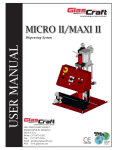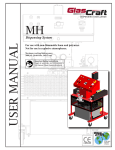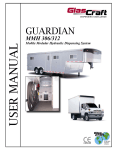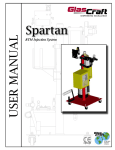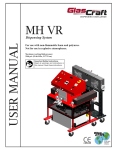Download GUARDIAN A6 12000 USER MANUAL GC1399
Transcript
GUARDIAN EN T IS P R CHINESE PATENT HI ZL 200630130159.1 T T M CT ED B Y U.S.A. PATENT D546,840 S E Q UI P T IS P R CT ED B Y HI EN TE O M TE O S E Q UI P USER MANUAL A6-12000 Dispensing System Table Of Contents Section 1 Installation 1:1 Introduction ........................................................................................................................................................ 1:2 Standard Equipment .......................................................................................................................................... 1:3 Specifications ..................................................................................................................................................... 1:4 Equipment Assembly .......................................................................................................................................... 1 2 3 4 Section 2 Operation 2:1 Start-up Instructions ........................................................................................................................................... 7 2:2 Shut–down Instructions ...................................................................................................................................... 10 2:3 Daily Start-Up Instructions ................................................................................................................................. N/A Section 3 General Information 3:1 Assembly Drawings ............................................................................................................................................. 3:2 Sub Assembly Drawings ...................................................................................................................................... 3:3 Maintenance ........................................................................................................................................................ 3:4 Troubleshooting ................................................................................................................................................... 3:5 Options ................................................................................................................................................................ 14 21 31 37 40 Section 4 Safety Information 4:1 General Safety ................................................................................................................................................. 42 ...................................................................................................................................... 46 4:3 Limited Warranty Policy ............................................................................................................ 47 4:4 Technical Assistance ................................................................................................................ 48 For Your Reference ............................................................................................. INSIDE BACK COVER 4:2 Notes N/A = Non Applicable The information in this document is intended only to indicate the components and their normal working relationship typical use. Each assembly should be directed by a GlasCraft distributor or made from the GlasCraft Assembly instructions provided. Before operating, maintaining or servicing any GlasCraft system, read and understand all of the technical and safety literature provided with GlasCraft products. If you do not have the proper or related manuals and safety literature for your GlasCraft system, contact your GlasCraft distributor or GlasCraft,Inc. This manual provides information for the assembly, operation, maintenance and service of this GlasCraft product as used in a typical configuration. While it lists standard specifications and procedures, some deviations may be found. In this GlasCraft technical and safety publication, the following advisories will be provided where appropriate: Is information about the procedure in progress. In order to provide our users with the most up-to-date technology possible, we are constantly seeking to improve products. If technological change occurs after a product is on the market, we will implement that technology in future production and, if practical, make it available to current users as a retrofit, up-date or supplement. If you find some discrepancy between your unit and the available documentation, contact your GlasCraft distributor to resolve the difference. GlasCraft, Inc. reserves the right to change or modify this product as it deems necessary. Is imperative information about equipment protection. Indicates a hazardous situation which, if not avoided, could result in minor or moderate injury. Careful study and continued use of this manual will provide a better understanding of the equipment and process, resulting in more efficient operation, longer trouble-free service and faster, easier troubleshooting. Indicates a hazardous situation which, if not avoided, could result in death or serious injury. Indicates a hazardous situation which, if not avoided, could result in electrical shock or serious injury. 1 Sec. 1:1 Section 1 - Installation: Introduction Sec. 1:2 Section 1 - Installation: Standard Equipment Model - A6-12000 Part Number Description 23685- A6-12000 UNIT 23950-02 PROBLER P2 GUN 22023-01 HIGH PRESSURE HOSE ASSEMBLY 18006-00 WHIP HOSE ASSEMBLY 23473-00 HEATER REPAIR KIT GC-1399 USER MANUAL 59934-04 DIOCTYL PHTHALATE, 1 QT. 22094-00 REQUIRED TO COMPLETE THE HOSE ELECTRICAL CIRCUIT WHEN USED WITH 18006-00 WHIP HOSE 2 Material Ratio: 1:1 (Fixed) Material Viscosity: 200- 2000 Centipoise (Cps) @ AMBIENT Output: Pumps Rated: .042 Gallons Per Cycle .159 Liters Per Cycle Operating Temperatures: 32º F ( 0º C ) - 180º (82 º C ) Operating Psi: 22:1 RATIO 2200 PSI @ 100 PSI Air Max Working PSI 2420 PSI Note: Overpressure switches are factory set at 2200 PSI. Purging: Constant Automatic Pneumatic, Solvent-free, Constant Electrical Requirements: 50 A @ 208/240 VAC,50/60 hz, Single Phase 35 A @ 208/240 VAC,50/60 hz. Three Phase 35 A @ 380 VAC, 50 hz. Three Phase Compressed Air Requirements: Base Unit: 1.0 GAL PER MINUTE – 17 CFM @ 100 PSI. 1.5 GAL PER MINUTE – 24 CFM @ 100 PSI. 2.0 GAL PER MINUTE – 33 CFM @ 100 PSI. NOTE: As output is increased, (achieved w/ chamber size on gun or spray tip), pressure drop will be greater. Heating capability will also drop. Heaters: 12000 WATT HEATER Maximum Hose Length: 300’ (Each Section 50’ x 3/8” I.D.) Shipping Weight: 428 Lbs. Overall Dimensions: 3 Sec. 1:3 Section 1 - Installation: Specifications Sec. 1:4 Section 1 - Installation: Equipment Assembly Assembly Instructions GlasCraft Systems are factory assembled. If any questions arise concerning air or electrical connections, please refer to illustrations located in the forward portion of this User Manual or contact your GlasCraft distributor. Fluid Line Connection The material hoses that bring Isocyanate and Polyol chemicals and the air from the machine to the gun should be connected as follows. Required Tools: Opened - end wrenches - 5/8”, 3/4” , 13/16” 1. Lay hoses out straight. 2. Couple hoses together with supplied union fittings and tighten finger-tight. 3. a. Hold crimp fitting hex (3/4”), and union fitting together, allowing the hose to hold it’s natural line. b. Using the appropriate wrench (A-side 3/4” / B-side 13/16”) tighten swivel fitting to union, not allowing crimp fitting or union to turn. Repeat on opposite side of union. This practice is required on all connection points. 1) Hose @ machine 2) Hose @ gun 3) Adding additional hose sections 4. Plug hoses together, The TRU-FLOW hose plugs are a twist-lock design. a. Push plugs together. b. Twist to lock position. Once connections are made, tape connections well enough to keep plugs from coming undone, damaged, etc. 4 Sec. 1:4 Section 1 - Installation: Equipment Assembly Main power from power source should be disconnected or turned off to console before making hose connections. 1. Connect Hose Assembly to the system. The swivel fittings on the Hose assembly are sized differently and will attach only one way. 2. Connect the twist-lock plugs to the plugs on the front of the system. Line the arrows up on each plug, push them together and twist to lock. (see hose installation) 3. Connect trigger air line to the air line on the system. 4. Connect whip hose assembly to the material hose. 5. Connect jumper p/n: 22094-00 to the plugs on material hose to complete the circuit. Note: Jumper not needed with 18006-01 heated whip hose. 6. Connect Hose Assembly and the gun as shown. The swivel fittings on the Hose assembly are sized differently and will attach only one way. 7. Fluid and air connections between the sytem and gun should now be complete and tight. 5 Sec. 1:4 Section 1 - Installation: Equipment Assembly Electrical Connections When Main Power to system console is on, the white and black wires in the console are always live! Disconnect or turn off Main Power source before opening console to make any repairs or before making any electrical repair of any type to the system. Electrical connections must be checked on a periodic basis. 1. 208/240 volt single phase L1 L2 GROUND 208/240 volt three phase L1 L2 L3 GROUND 380 volt three phase L1 (black) L2 (brown) L3 (black) L4 (blue) GROUND (green) 2. The transformer can now be set for proper hose length. If you do not understand the electrical hook-up described above, consult your local GlasCraft distributor OR a qualified electrician. Air Supply Connection An air source which delivers a constant 25 CFM @ 90110 PSI (708 liters @ 6.3-7.7 BAR) and does not exceed 125 PSI (14 BAR) should connected directly to the Ball Valve, P/N 21666-01, mounted on the Proportioning Unit Air Motor. (see “Typical System Connection Diagram” illustration) The air line to the Console should be a minimum 1/2 inch inside diameter (I.D.) if it is 25 feet or less in length. Should it be over 25 feet in length, the air line should be a minimum 3/4 inch I.D. 6 Section 2 - Operation: Start-Up Instructions Filling The System Never leave machine unattended while system power is on or system is running. System running is defined as: preheat cycle of the hose heat, primary heaters, or any pump operation. Machine operators must be familiar with the component functions and operation of the machine. 1. Adjust Air Regulator to 20 PSI to fill system. Air Sec. 2:1 Motor will cycle slowly to fill Pumps, Heaters and Hoses and stop. Pre-Operation Check List A. Check that all fittings are securely tight. B. Check electrical hook-up (qualified electrician recommended). C. Main power switch on Control Box should be 2. Remove ISO & POLY side blocks from gun. switched to OFF position. D. Air Regulator turned (counter clock-wise) to OFF position. E. Hose Control and Primary Heater Control to OFF position. Do not place any part of the body in the path of the material spray. Do not point the gun at or near other personnel. Do not look into the Mixing Chamber orifice at any time. Because of the hazardous materials used in this equipment, it is recommended that the operator use an air mask, goggles, protective clothing, and other safety equipment as prescribed by current regulations, recommendations of the chemical suppliers, and the laws in the area where the equipment is being used. PROBLER P2 MAKE SURE VALVES ARE OFF Initial Start-Up Procedure With all material and air lines connected and power cable attached, the system is now ready for start-up. 7 Section 2 - Operation: Start-Up Instructions 3. Place separate clean containers under each indi- 6. Clean and lubricate Side Blocks and Seals thoroughly vidual side block. Slowly open material valves (black arrow forward) on each side block to allow trapped air to escape the hose and material to flow into the containers until all air is purged from the material system. and re-assemble on Gun. Make certain that the side block screws are tighten securely. 7. Refer to material manufacturers operating instructions Sec. 2:1 for proper preparation of material, i.e, mixers, etc. 8. Leave Air Regulator at 20 PSI 9. Turn main power Switch to ON position. Remember to dispense one to two gallons of material to clear the system of grease and plasticizer that was used during factory testing. 4. Close manual material valves. Material pressure gauges should now register approximately equal pressure. If one side registers considerably more pressure than the other side, go to the high pressure side and bleed off some pressure by slightly opening the manual material valve on the side block over the container. Bleed pressure until both sides are approximately the same pressure. 10. Turn on Hose Control: a. Push in the green power button. b. Press up or down arrow buttons on the controller until desired temperature setting is achieved. 5. Dispose of waste material properly and in accordance with chemical suppliers instructions and local, state and federal regulations. Before re-assembling Side Blocks, lubrication can be applied by dabbing a white lithium grease into holes inside of Gun Front Housing and wiping grease over SideBlock Seals. Grease will purge itself when air valve is turned on at Gun and Gun is triggered. 8 Section 2 - Operation: Start-Up Instructions 11. Turn on the ISO & POLY Heater control: 12. Adjust Main Air Regulator to material suppliers specifications. Sec. 2:1 a. Push in green power button. b. Press up or down arrow buttons on the controller until desired temperature setting is achieved. 13. Turn Purge Air and Material Valves ON at Gun. Straighten hose out flat, to avoid uneven heating and damage to internal wiring of the Hose Assembly. Allow enough time for hose to warm up (approximately 15- 20 minutes). Remember that the heated hose does not have a delta rating. The heated hose’s function is to maintain the heat generated by the primary heaters during system operation, and preheat material during initial start-up. The hose should be set to maintain a temperature close to the set point of the heaters. ON Due to the expansion of urethanes when heated, it is imperative that on cold start-up of the system that the heaters be turned on and allowed to reach operating temperatures before the Main Pump Air Regulator is adjusted to the desired spray pressure. If you do not allow the heaters to reach operating temperature before adjusting air pressure, the material pressure will exceed the set point of the over pressure switches causing the system to shut down. OFF 14. Relieve any excess pressure by triggering the gun. The Emergency Stop Switch is located on the bottom right side of the control Panel, when depressed, it will shut down the power and activate the Air Dump Valve. To reset, turn handle on push button. 15. The system is now ready for operation. 9 Section 2 - Operation: Shut-Down Instructions Daily Shut-Down Procedure 5. Reduce main air regulator pressure to zero. Sec. 2:2 1. Turn off hose and heater controllers. 2. Turn off main power switch. 6. Visually inspect the entire system for leaks. 7. Turn off main air supply and main power. 3. Flip retract switch to the “retract position” and trigger the gun until pumps are in the down position. 4. Perform gun maintenance. (See gun manual) 10 Section 2 - Operation: Shut-Down Instructions 8. Coil heated hoses with a minimum four foot diameter 1. Remove side blocks from the gun and relieve pressure to avoid kinking and subsequent damage to the internal electrical wiring. from the system. 9. Check and lube top of the fluid section. Sec. 2:2 Wipe off residual material and add a tablespoon of DOP,DBP PROBLER P2 2. Use a suitable solvent to flush the fluid circuits. To determine the compatibility of solvents with material being used. Always check with material supplier. 3. Increase transfer pump pressure until fluid movement occurs. Do not bleed fluid pressure from the system. If fluid movement does NOT occur @ 100 psi of air on transfer pumps, increase main pump pressure until the main proportioner SLOWLY starts cycling. Extended Shut-Down Procedure There are many different procedures that are being followed for extended machine shut down. Because the system is designed to be compatible with most urethane formulations, GlasCraft recommends that the system should be stored with urethanes instead of solvents, plasticizers, etc. Certain considerations have to be adhered to when an extended shut-down is being performed. The following procedure is for long extended shut-down periods. 4. Once primary material is flushed from the system, reduce the main air pressure to zero or flip the retract switch to the “retract position” and trigger the gun until the pumps are in the down position. 5. If the solvent used to flush the system also contains placticizer, ensure that all primary material is flushed from the system and close the ball valves @ the gun. 6. Leave the pumps in the full down stroke position with approximately 200-500 psi. on the fluid gauges. Power should be disconnected and all air regulators turned down to zero. 7. If plasticizer is required to chase out solvent, cycle main pumps until the system is full of plasticizer, then close valves and leave the pumps in the full down stroke position with 200-500 psi. 11 Section 2 - Operation: Shut-Down Instructions 8. Turn off main air supply and disconnect air line from 2. Adjust main air regulator to 20 psi. Sec. 2:2 the system. 3. Adjust transfer pump regulators to approximately 40 psi. 9. Generously coat the exposed transfer pump shafts with lithium grease. 10. Coil the heated hoses with a minimum four foot diameter to avoid kinking and subsequent damage to the internal electrical wiring. 11. For gun shut down, follow the procedure from the gun manual. 12. The length of time a system is shut down, and the climate conditions it’s stored in will determine how often the system should be purged and refilled. Usually every 2 - 4 weeks the following procedure should be followed. 4. Remove the side blocks from the gun. Purge and Refill Procedure 1. Connect the main air line to the system. PROBLER P2 12 Section 2 - Operation: Shut-Down Instructions 5. Open both side blocks simultaneously into separate Before performing any repairs on any part of the system, PLACE ALL CONTROLS ON THE MACHINE AND THE MAIN POWER SOURCE IN THE OFF POSITION AND DISCONNECT THE ELECTRICAL POWER CABLE FROM THE MAIN POWER SOURCE! 6. Close both side blocks simultaneously and wipe off residue from the side block seals. Regrease and attach both blocks to the gun. 7. Mix and properly dispose of purge material. Before performing any repairs on the system, ALL AIR and FLUID PRESSURES SHOULD BE RELIEVED TO ZERO (BLEED-OFF)! To relieve Air and Fluid pressures: System Console: 1. Turn OFF valves that supply material to the Pumps. 2. Turn OFF Main Air Regulator on Air Motor. Gun: 1. Open both Side Block Material Valves. 2. Turn ON Air Switch. 3. Point Gun into a clean, suitable container and trigger Gun until material flow stops. 4. Fluid pressure gauges must read zero (0), if not, trigger Gun until the fluid pressure gauges do read zero (0) pressure. 5. Turn OFF Side Block Material Valves. 6. Trigger Gun several more times to purge any material remaining in Gun. Turn OFF air Switch. 7. Unless system is to be returned to service at once, follow DAILY SHUT-DOWN PROCEDURE 13 Sec. 2:2 containers and dispense approximately 1-1/2 - 2 gallons of material from each side or until all plasticizer is purged from the system. Stop the pumps in the down position. Section 3 - General Information: Assembly Drawings Sec. 3:1 23685-XX Unit Assembly 14 REVISION C Section 3 - General Information: Assembly Drawings Sec. 3:1 23685-XX Unit Assembly 15 REVISION C Section 3 - General Information: Assembly Drawings Sec. 3:1 23685-XX Parts List Part Number Description Part Number Description RS-118 ISO DECAL 3795-00 TERMINAL LUG RS-119 POLY DECAL 3800-03 WIRE RS-121 HOSE DECAL 3800-08 WIRE RS-124-01 MAIN DECAL 7208-04 WIRE NUT RS-126 HOSE CURRENT DECAL 7361-00 TERMINAL LUG RING 14638-02 RIVET 7486-05 WASHER 19818-02 TERMINAL LUG 7486-28 WASHER 20188-12C SCREW 7734-06 LOCK WASHER 20188-20C SCREW 7734-10 LOCK WASHER 20188-28C SCREW 8155-64C SCREW 20655-06 ELBOW FITTING 8560-03 FITTING 20895-00 CABLE 8846-03 WIRE 21094-01 ELBOW FITTING 8846-08 WIRE 21110-00 #6 WIRE 8847-08 WIRE 21129-00 TRANSFORMER DECAL 9704-07 TUBING 21150-00 TERMINAL LUG 21819-00 LIVE WIRE DECAL 21839-00 DIN CONNECTOR 21847-00 HOSE THERMOCOUPLE 21874-00 THERMOCOUPLE 21953-32 SCREW 22088-03 TWIST-LOCK PLUG 22088-08 TWIST-LOCK PLUG 22178-00 ON/OFF POWER SWITCH 22502-00 CIRCULAR PANEL JACK 22509-00 CONTROL CABLE 23447-00 BOTTOM PLATE 23450-XX GUARDIAN HYBRID ASSEMBLY 23453-00 HEATER COVER 23454-00 FIBERGLASS SHELL 23457-00 CONTROL PANEL RING 23460-01 GUARDIAN PUMP ASSEMBLY 23468-00 HOSE 23469-00 RIVET NUT 23470-00 FIBER WASHER 23478-01 CONTROL PANEL ASSEMBLY 23479- ELECTRICAL ASSEMBLY 23481-00 BLACK DECAL 23490-00 ISO HEATER 23491-00 POLY HEATER 23494-00 A6-12000 DECAL 3201 LUG RING 3795-00 TERMINAL LUG RING 16 REVISION C Section 3 - General Information: Assembly Drawings Sec. 3:1 23485-XX Generic System Schematic 17 REVISION C Section 3 - General Information: Assembly Drawings Sec. 3:1 23685-XX System Schematic 220V Single Phase 18 REVISION C Section 3 - General Information: Assembly Drawings Sec. 3:1 23685-XX System Schematic 220V Three Phase 19 REVISION C Section 3 - General Information: Assembly Drawings Sec. 3:1 23685-XX System Schematic 380V Three Phase 20 REVISION C Section 3 - General Information: Sub Assembly Drawings Sec. 3:2 23450-XX Hybrid Assembly 21 REVISION D Section 3 - General Information: Sub Assembly Drawings Sec. 3:2 23450-XX Hybrid Assembly Part Number Description Qty. RS-141-02 CORD GRIP 4 T4-161-01 CONNECTOR 1 10009-19 ELBOW FITTING 2 17702-00 PILOT LAMP 1 18101-01 FITTING 1 19507-03 AIR HOSE 1 20188-12C SCREW 14 20226-00 SET SCREW 1 21119-00 TRANSFORMER 1 21145-01 VENT PLUG 7 21809-07 MATERIAL HOSE 2 21866-00 COUPLING PLATE 1 21886-00 LAMP MOUNTING BLOCK 1 22142-00 TRANSFORMER 1 22150-02 PILOT LIGHT 1 22162-00 CONNECTOR 1 22163-00 AMMETER 1 22502-00 PANEL JACK 2 Part Number Description Qty. 23448-00 HANGER 2 1017-00 FITTING 3 23451-00 HEATER COVER 2 18199-02 AIR REGULATOR 2 23452-00 AMMETER BRACKET 1 18318-02 AIR GAUGE 2 23455-00 2 WHEEL CART 1 18318-04 AIR GAUGE 1 23462-00 FITTING 2 20655-04 ELBOW FITTING 1 23463-00 BULKHEAD NUT 2 21666-01 BALL VALVE 1 23467-00 WHEEL 2 23449-00 “L” BRACKET 1 AIR MANIFOLD 1 23474-00 AIR MANIFOLD 1 23459-00 23476-00 FLUID MANIFOLD 1 398 OILER CAP 2 23482-00 MANIFOLD DECAL 1 399 OILER CAP GASKET 4 5307-01 CONDUIT NUT 4 4342-04 ELBOW FITTING 1 5307-03 CONDUIT NUT 1 6782-03 TEE FITTING 1 5363-01 COTTER PIN 2 7734-07 LOCK WASHER 2 7315-09 RUBBER GROMMET 2 8115-03 FITTING 2 7315-11 RUBBER GROMMET 1 8115-06 FITTING 2 7486-07 WASHER 4 8115-07 FITTING 1 7486-11 WASHER 1 8156-24C SCREW 2 7486-27 WASHER 5 7733-14 HEX NUT 4 7734-03 LOCK WASHER 5 7734-06 LOCK WASHER 14 7734-07 LOCK WASHER 6 7735-40C SCREW 1 8156-32C SCREW 6 8160-12F SET SCREW 4 8301-12C SCREW 4 22 REVISION D Section 3 - General Information: Sub Assembly Drawings Sec. 3:2 23460-01 Proportioning Assembly Part Number Description Qty. Part Number Description Qty. 10599-40F SCREW 2 7486-04 FLAT WASHER 8 19858-00 STAND-OFF 2 7486-10 FLAT WASHER 2 19859-00 PUMP MOUNTING PLATE 1 7486-27 FLAT WASHER 2 19861-00 PUMP SADDLE 1 7596-03 FITTING 1 19984-00 STAND-OFF 4 7729-10 NUT 2 2 20188-12C SCREW 4 7733-06 NUT 20735-08 ELBOW FITTING 1 7734-03 LOCK WASHER 2 21613-48C SCREW 4 7734-06 LOCK WASHER 4 21806-00 LEFT GUARD 1 7735-40C SCREW 2 21807-00 RIGHT GUARD 1 7957-32C SCREW 2 21830-00 PRESSURE SWITCH 2 7966-17 FITTING 2 21835-00 MATERIAL PUMP 2 8155-40C SCREW 4 21836-00 POPPET VALVE 1 8560-03 FITTING 2 22086-02 RETRACT SWITCH KIT 1 9955-32C SCREW 2 22101-00 LIMIT SWITCH 1 9672-11 FITTING 1 23411-00 ELBOW FITTING 2 AM-600-00 6” AIR MOTOR 1 23461-00 PUMP MOUNTING BRACKET 1 4342-05 ELBOW FITTING 2 6782-23 TEE FITTING 2 23 REVISION B Section 3 - General Information: Sub Assembly Drawings Sec. 3:2 AM-600 Air Motor 24 Section 3 - General Information: Sub Assembly Drawings Sec. 3:2 21835-00 Fluid Section Part Number Part Number Description APS-119 FOOT VALVE SEAT APS-128 Qty. Description Qty. 21595-00 PUMP SEAL 2 21597-00 TRANSFER HOUSING 1 21598-00 TRANSFER SEAT 1 21599-00 PUMP SHAFT 1 21803-00 COMPRESSION SPRING 1 1 21896-01 PACKING RETAINER 1 CHROME BALL 1 21897-01 FELT WIPER 4 APS-133 SST BALL 1 7733-17 HEX NUT 4 FS-110 NYLON PISTON GUIDE 1 7734-07 LOCK WASHER 4 P33-11 PUMP BASE 1 7734-12 LOCK WASHER 4 1005-02 SNAP RING 1 9945-48C SCREW 4 13867-43 O-RING 3 13867-44 O-RING 1 18219-00 PUMP CYLINDER 1 18227-00 AIRLESS PUMP HEAD 1 18289-00 PUMP TIE ROD 4 13867-43 O-RING 3 18295-01 SUPPORT WASHER 1 13867-44 O-RING 1 19633-00 COMPRESSION SPRING 1 21595-00 PUMP SEAL 2 19634-00 FOOT VALVE HOUSING 1 21896-01 PACKING RETAINER 1 19857-00 PUMP SHAFT EXTENSION 1 21897-01 FELT WIPER 4 21440-00 SOLVENT CUP ADAPTER 1 FS-110 PISTON GUIDE 1 REPAIR KIT: 21845-00 21845-00 REPAIR KIT Part Description Qty. Number 25 REVISION E Section 3 - General Information: Sub Assembly Drawings Sec. 3:2 23478-01 Control Panel Assembly Part Number Description Qty. Part Number Description Qty. 21112-00 COUNTER 1 23486-02 FEMALE PLUG 2 21164-00 1/2 AMP FUSE 3 23486-03 FEMALE PLUG 1 21164-02 2 AMP FUSE 1 23487-02 MALE PLUG 2 21356-02 CONTROL 3 23487-03 MALE MALE 1 21823-00 DIN RAIL .875 RS-122 PRIMARY DECAL 1 21872-00 ISO DECAL 1 RS-127 HOSE CONTROL DECAL 2 21873-00 POLY DECAL 1 23070-00 PUSH BUTTON 2 21889-00 FUSEHOLDER 4 23071-00 PUSH BUTTON 3 22104-00 EMERGENCY STOP DECAL 1 23073-00 EMERGENCY STOP 1 22117-00 TERMINAL BLOCK JUMPER 2 23079-01 OPEN CONTACT BLOCK 5 22414-00 CYCLE COUNTER DECAL 1 23079-02 CLOSE CONTACT BLOCK 5 22422-01 RELAY 4 23074-00 COUPLING PLATE 6 22423-01 RELAY SOCKET 4 23075-03 “R” CAP 3 22506-00 TERMINAL 6 23075-05 ”I/O” CAP 2 22507-00 END COVER 3 23078-01 YELLOW LED 3 22753-01 OVERPRESSURE DECAL 3 23078-03 GREEN LED 2 23456-01 CONTROL PANEL 1 23076-01 YELLOW CAP 3 23076-03 GREEN CAP 2 26 REVISION C Section 3 - General Information: Sub Assembly Drawings 23479- Electrical Assembly 23479-02 220 V Single Phase 23479-02 Description 14638-02 RIVET Qty. 3 21164-02 2AMP FUSE 2 21823-00 DIN RAIL 17” 21888-06 CIRCUIT BREAKER 1 21888-09 CIRCUIT BREAKER 2 21889-00 FUSEHOLDER 2 22119-00 63AMP FUSE BLOCK 1 22143-00 TAB BOLTED 63AMP FUSE 1 22146-01 SOLID STATE RELAY 1 22146-02 SOLID STATE RELAY 2 22171-03 SWITCH BLOCK 1 22174-03 SWITCH BLOCK COVER 1 23466-00 ELECTRIC CONTACTOR 3 7486-28 WASHER 3 23479-05 220 V Single & three Phase 23479-05 Part Number 27 Description 14638-02 RIVET Qty. 3 21164-02 2AMP FUSE 2 21823-00 DIN RAIL 1 21888-06 CIRCUIT BREAKER 1 21888-09 CIRCUIT BREAKER 2 21889-00 FUSEHOLDER 2 22119-00 63AMP FUSE BLOCK 1 22143-00 TAB BOLTED 63AMP FUSE 1 22146-01 SOLID STATE RELAY 1 22146-02 SOLID STATE RELAY 2 22171-01 SWITCH BLOCK 1 22174-01 SWITCH BLOCK COVER 1 23466-00 ELECTRIC CONTACTOR 3 7486-28 WASHER 3 Sec. 3:2 Part Number Section 3 - General Information: Sub Assembly Drawings 23479- Electrical Assembly Sec. 3:2 23479-06 380 V Three Phase 23479-06 Part Number Description Qty. 14638-02 RIVET 21164-02 2AMP FUSE 3 2 21823-00 DIN RAIL 17” 21888-06 CIRCUIT BREAKER 1 21888-09 CIRCUIT BREAKER 2 21889-00 FUSEHOLDER 2 22119-00 63AMP FUSE BLOCK 1 22143-00 TAB BOLTED 63AMP FUSE 1 22146-01 SOLID STATE RELAY 1 22146-02 SOLID STATE RELAY 2 22157-00 TERMINAL BLOCK 1 22171-02 SWITCH BLOCK 1 22174-02 SWITCH BLOCK COVER 1 23466-00 ELECTRIC CONTACTOR 3 7486-28 WASHER 3 28 Section 3 - General Information: Sub Assembly Drawings Sec. 3:2 23490-00 ISO / 23491-00 POLY Heat Exchanger Assembly Part Number Description Qty. 11021-23 PIPE PLUG 4 13076-18 O-RING 8 20653-00 FITTING 1 21068-06C SCREW 8 21074-00 THERMOCOUPLE 1 22019-00 HEATER ELEMENT 4 22108-00 OVERTEMP SWITCH 4 22633-00 COMPRESSION SPRING 4 23444-00 HEATER BODY 2 23483-01 FEMALE ELECTRICAL PLUG 1 23484-01 MALE ELECTRICAL PLUG 1 23486-01 FEMALE ELECTRICAL PLUG 1 23487-01 MALE ELECTRICAL 1 23488-00 HEATER TOP CAP 1 23489-00 HEATER BOTTOM CAP 1 7734-01 LOCK WASHER 8 7734-06 LOCK WASHER 24 7959-56C SCREW 24 29 23490-00 REVISION B 23491-00 REVISION B Section 3 - General Information: Sub Assembly Drawings Sec. 3:2 22023-01 High Pressure Hose Assembly Part Number Part Number Description Qty. Description Qty. 10262-04 NYLON FLUID HOSE 50 ft. 19506-01 COPPER STRIP 6 lbs. 11745-10 HEAT SHRINK TUBING SHRINK 1 ft. 21341-01 MATERIAL HOSE 100 ft. 13424-03 CABLE TIE 4 22036-00 HEAT TAPE END SEAL 4 13424-05 CABLE TIE 1 22088-01 MALE ELECTRIC PLUG ASSEMBLY 2 15998-02 NEOPRENE TUBING 100 ft. 22088-02 FEMALE ELECTRIC PLUG ASSEMBLY 2 17895-01 UNION FITTING 1 23607-00 COLD SPLICE KIT 4 17896-01 UNION TUBE FITTING 1 23608-00 SPLICE CONNECTOR 4 17944-03 HOSE FITTING 2 18009-02 HOSE FITTING 2 18012-03 HEATED HOSE COVER 50 ft. 18101-01 ADAPTER FITTING 1 19490-01 HOSE FITTING 2 30 Section 3 - General Information: Maintenance Daily Routine Maintenance 2. Flush system side to be rebuilt with suitable solvent. Step three is optional, but it makes the process easier. 1. Visually inspect the system for leaks. 2. Check desiccant dryer beads to insure they are 3. Disconnect inlet and outlet fittings from the pump. still purple and have not changed to pink. Wipe off residual material and add a tablespoon of DOP,DBP a. remove outlet hose b. remove inlet hose Weekly Maintenance 4. Disconnect the din connector from over pressure switch. a. remove plug 1. Place a small amount of grease on the air motor shaft. 2. See related manuals. Overhaul Procedure 19875-00 (-01) Pumps / 21835-00 Pumps 1. Dump pressure off system Be sure the air and power are off to system. b. Remove Switch from fitting. This is achieved by removing side blocks from the gun, opening ball valves and purging materials into clean containers. 31 Sec. 3:3 3. Check and lube top of the fluid section. Section 3 - General Information: Maintenance 2. Remove Base from Tie Rods. Do not immerse Over Pressure Valve in solvents externally. (Flushing will not affect). 5. Remove pump from base. Sec. 3:3 a. remove nylon Lock nut from yoke. 3. Remove Valve Housing from the cylinder. P/N UF-118 on 19875-00 pump. P/N, 19634-00 on 21835-00 pump. b. remove four bolts 4. Using a rubber mallet, tap shaft out through the bottom of the cylinder, P/N 18219-00. Breaking Down Pump 1. Remove four nuts at the base of pump break loose, in a criss-cross pattern. 5. a. Remove cylinder, P/N 18219-00 from pump head P/N 18227-00. b. Remove Cup Adapter, P/N 21440-00 from pump head P/N 18227-00. On P/N 21835-00 pumps, watch out for APS-119, APS128, & 19633-00. The spring will push these parts out. Observe which side of the APS-119 comes out, Keep right side up for diagnostics. 32 Section 3 - General Information: Maintenance Disassemble Sub-Assemblies b. Remove FS-110, Piston Guide and P/N 21595-00 Pump Seal. 1. Cup Adapter, P/N 21440-00. a. Remove Support Washer, P/N 18295-01. Sec. 3:3 b. Remove Seal, P/N 21595-00. Cleaning c. Remove Snap Ring, P/N 1005-02, Nylon Washer, P/N 21896-01, & Felt Wipers, P/N 21897-01. 1. Thoroughly wash all parts in suitable solvent. 2. If parts have any build-up of hardened material, it is acceptable to polish parts with fine sand paper, (1200 grit) or steel wool(000). 3. It is recommended that the cylinder be honed with a fine grit bead honer,(P/N RK5-2). Inspection 1. The Pump Cylinder, P/N 18219-00 inner wall should be smooth. No pitting or scarring should be seen. If slight scars show in the wall, they must not be able to be felt with a finger nail. 2. Shaft Assembly: 2. The Pump Shaft, P/N 21599-00 must not have any a. Remove P/N 21598-00, Transfer Seat from P/N 21597-00, Transfer Housing. scoring, pitting, or build up of any debris on the shaft. 3. Set the Ball, P/N APS-133 in the Seat, P/N 21598-00 and hold up to a light. Observe for light between the seat surface and the ball. P/N APS-133, Ball is loaded with spring tension. If a large sliver of light shows, check for debris or scaring on Seat or Ball. 4. P/N APS-128 & P/N APS-119 repeat the above step. The APS-119 is reversible, you can use either side. 33 Section 3 - General Information: Maintenance Re-Assemble 5. Install P/N 18295-01 with lip facing toward the seal P/N 21595-00. All parts underlined are contained in Repair Kit. 1. Soak P/N 21897-01 in a light weight, non detergent oil, then install in P/N 21440-00. 2. Install P/N 21896-01, push down and install Snap Ring P/N 1005-02 in groove. Sec. 3:3 6. Place P/N 21595-00 Seal and P/N FS-110 guide on P/N 21597-00. The lips of the Seal will face away from P/N FS-110. 3. On bottom side of P/N 21440-00 install P/N 21595-00 so that the lip faces out 7. Set P/N 21803-00 spring in P/N 21597-00 housing and set APS-133 ball on Spring. 8. Apply blue lock-tite to the threads of P/N 21598-00 and install on P/N 21597-00. Tighten these two parts! 4. Lubricate and install O-Ring, P/N 13867-43 on bottom groove. 34 Section 3 - General Information: Maintenance 12. With the Pump Assembly upside down, (easy if P/N 18219-00 cylinder. clamped in a vise) install Foot Valve Housing P/N 19634-00. (21835-00 Pump) 10. Using a light weight non-detergent oil, coat the seal on the shaft assembly and the walls of the cylinder, then install the shaft assembly into the cylinder, leave approximately 4” of the shaft exposed on the top side. P/N UF-118 & P/N 2594-43 (19875-00 Pump) 13. Set P/N 19633-00 Spring in place and set P/N APS-128 Ball on Spring. For the 19875-00 pump, set the APS-128 ball in the housing. 11. Install cylinder/shaft assembly into P/N 18227-00 pump Head, careful not to cut O-Ring for pump P/N 21835-00. 35 Sec. 3:3 9. Lubricate and install two P/N 13867-49 O- Rings on Section 3 - General Information: Maintenance 14. Lubricate and install P/N 13867-44 O-Ring in the 17. Continue holding P33-11 down, install (4) P/N 7734-12 Lock Washers and hand thread (4) P/N 7733-17 Nuts. Tighten P/N 7733-17 in a criss-cross pattern until tight. Sec. 3:3 groove of P/N 19634-00. 15. Lubricate the outer edge of P/N APS-119 and set top of ball, square and center flats of P/N APS-119 and P/N 19634-00. 16. Gently set P/N P33-11 through P/N 18289-00 Tie Rods and push down square and firm until it sets down over cylinder O-Ring. 36 Section 3 - General Information: Troubleshooting If a high pressure situation develops, the sensor will detect this and immediately engage the hold-in circuit. This will disengage power to the air motor and will also turn the heaters off. On the control box panel, there are three yellow lighted push buttons marked over pressure. One of these push buttons will be illuminated after the monitoring sensor engages, indicating where the problem is located (ISO, Poly, or Hose). Sec. 3:4 Do not place any part of the body in the path of the material spray. Do not point the gun at or near other personnel. Do not look into the Mixing Chamber orifice at any time. Because of the hazardous materials used in this equipment, it is recommended that the operator use an air mask, goggles, protective clothing, and other safety equipment as prescribed by current regulations, recommendations of the chemical sup pliers, and the laws in the area where the equip ment is being used. The system will dispense liquid at high pressure when Gun Trigger is activated. Read and note WARNINGS contained in this User Manual and the Probler P2 Gun User Manual, GC-1386. The Polyol will expand in the Hose if any normal operating pressures are bled off whenever the material is above approximately 75 degrees F. Hot Polyol hoses should never be bled, by any method, to zero pressure for two reasons. 1. The seals in the Gun rely on high pressure to make their seal. The high pressure cannot be maintained if the pumps are attempting to apply this pressure through a hose full of expanded froth; therefore, the Gun seal may leak. 2. Re-starting immediately after hot Polyol has expanded in the system may result in spraying substantial amounts of “bad” foam. This will continue until the expanded Polyol in the primary Heater and the Hose has been completely purged. In the over pressure situation, the system will remain shutdown until it is manually reset. At this point, it is necessary to determine if the problem is an over pressure situation. When the sensor engages, the system will be frozen, giving you the pressure readings at the time the problem was detected. Inspect the fluid pressure gauges, in an over pressure situation, one of the fluid pressure gauges will be significantly higher than the other gauge. Over Pressure System Protection The system incorporates monitors for high pressure monitoring. These monitoring devices will prevent the system from continued operation if high pressure situations develop. There are pressure sensors located on each propor tioning pump. The high pressure sensor is located at the outbound of the fluid section. When main power to unit is on, the console will have wires that are live. Disconnect or turn off main power source before opening console to make any repairs. Before performing any repairs on the system, ALL AIR and FLUID PRESSURES SHOULD BE RELIEVED TO ZERO (BLEED-OFF)! The high pressure monitoring sensor will engage if fluid pressure increases above 2200 psi. 37 Section 3 - General Information: Troubleshooting • WHAT GOOD MATERIAL LOOKS LIKE. • HOW THE EQUIPMENT NORMALLY OPERATES. Over Pressure Problem Correction 1. Determine if the problem is high pressure related. • WHAT PATH THE MATERIALS FOLLOW THROUGH THE EQUIPMENT. 2. Relieve system material pressure. • KNOWLEDGE OF THESE TROUBLESHOOTING PROCEDURES. 3. Turn off main power. Always start with step one, never skip any portion of these procedures. The material pressure gauges are to be used for troubleshooting purposes only. The pressures registered on one gauge will not necessarily match the other. This difference can be caused by variance in materials, temperatures, viscosities, etc. Sec. 3:4 4. Fix the problem area: a. Potential high pressure causes: -Restriction -Overheating material in static position -ISO filter at gun 5. Re-start system for operation 1. Identify the missing material. 2. Check the material pressure gauge on the Once the power has been turned off and problem solved, and the main power is turned on again, the over pressure lighted buttons will automatically be reset. missing material side. a. If the missing material gauge reads HIGHER than normal, there is a RESTRICTION problem between the gauge and the Mixing Chamber tip in the Gun. If you do not understand the electrical hook-up de scribed above, consult your local GlasCraft distributor OR a qualified electrician. b. If the missing material gauge reads LOWER than normal, there is a STARVATION problem between the gauge and the material supply system. It is recommended that a qualified, licensed electrician should install power to the supply disconnect. Problems may be cyclic in that they will appear first on only one stroke of the Proportioning Pump. Check the pressure gauges during one of these bursts of missing materials and always stop spraying while you are getting a burst of good material. You should always follow all local or national electrical codes. Disconnect power source BEFORE attempting any repairs or opening the Control Boxes. Access to internal parts is limited to qualified personnel ONLY! Place Main Power Switch in OFF position BEFORE disconnecting power cables. This equipment is not approved for use in hazardous locations as set forth in the National Electrical Code Article 500 and Sub-Part “S” of the OSHA Standards. 3. Concern yourself only with the material pressure Material Or Mechanical Problem Troubleshooting Procedure By following this procedure, you should be able to locate and cure problems easily. Remember, however, that a successful operator must know: 38 on the missing material side. In troubleshooting a STARVATION problem where the pressure gauge on the missing material side is LOWER than normal, start at the point farthest from the unit and work forward. Check the obvious and easy things first. Section 3 - General Information: Troubleshooting A. MATERIAL DRUMS 1. Material in drums? 2. Material temperature? a. If the material is to cold, especially at the bottom of the drum, it will raise the viscosity of the material and stall Transfer Pumps. A. GUN 1. Side Block Material Valve turned on? 2. Bore hole of Mixing Chamber clean? 3. Filter Strainer Screen clean? 4. Side hole in Mixing Chamber clean? B. MATERIAL TEMPERATURE 1. Too high a temperature on resin side can cause a blowing agent to pre-expand in either the Hose or the Primary Heater. C. HOSES 1. Make sure that the Hoses are not plugged. TROUBLESHOOTING A POOR SPRAY PATTERN To troubleshoot a poor spray pattern, you must understand the factors that affect the spray pattern. C. FILTER ASSEMBLY 1. Check fluid filter at inlet to Proportioning Pumps if applicable. D. PROPORTIONING PUMPS 1. Determine whether the burst appears on the Pump’s up or down stroke. a. If burst appears on UP stroke, check UPPER Ball Seat and Cups. b. If burst appears on DOWN stroke, check LOWER Ball Seat Follow the procedures in the order given. Remember that repairs should be made as soon as possible. Don’t leave the unit open to air any longer than necessary, as this will lead to further problems, such as moisture entering the system and causing the isocyanate to crystallize. A. TEMPERATURE 1. Too warm a material temperature will cause a separation (fingering) in the pattern. 2. Too cold a material temperature will cause a stream effect. B. PRESSURE 1. Too high a pressure will cause excessive overspray and/or separation (fingering). 2. Too low a pressure will cause a stream effect. C. CONTAMINATION IN THE MIXING CHAMBER 1. A foreign object in the Mixing Chamber will cause a poor pattern. Correct problem(s) immediately! After the unit has been exposed to the atmosphere, it should be run long enough to displace the material that was in the unit when it was opened up. NEVER inspect filter assemblies at time of shut-down! 4. In troubleshooting, a restriction problem where the material pressure gauge on the missing material side is higher than normal, start at the point farthest from the unit and work backward. Check obvious and easy things first. Before performing any repairs on the Gun, ALL AIR and FLUID PRESSURES SHOULD BE RELIEVED TO ZERO (BLEED-OFF)! 39 Sec. 3:4 B. OPTIONAL TRANSFER PUMP(S) 1. Is it operating? 2. Is air turned on to Transfer Pump? 3. Regulated pressure where it should be? 4. Severe contamination of pump shaft on isocyanate side. This indicates that the pump shaft is not being lubricated. 5. Check Filter of Transfer Pump. 6. Before diagnosing a faulty Transfer Pump, be sure and check all items just listed under Transfer Pump. Section 3 - General Information: Options Sec. 3:5 17666-04 Diaphragm Transfer Pump Kit The transfer kit attaches the same way for both ISO & POLY side. Use teflon tape on NPT threads. 40 REVISION A Section 3 - General Information: Options Sec. 3:5 17666-05 Transfer Kit The transfer kit attaches the same way for both ISO & POLY side. Use teflon tape on NPT threads. 41 REVISION A Section 4 - Safety Information: General Safety Organic Peroxides and Dual Component Coatings. Local codes and authorities also have standards to be followed in the operation of your spraying equipment. Chemical manufacturer’s recommendations should be obtained and considered. Your insurance carrier will be helpful in answering questions that arise in your development of safe procedures. Safe Handling And Use Of Urethane Foam Equipment Introduction Any tool, if used improperly, can be dangerous. Safety is ultimately the responsibility of those using the tool. In like manner, safe operation of polyester processes is the responsibility of those who use such processes and those who operate the equipment. This manual outlines procedures to be followed in conducting polyester operations safely. Personnel Safety Equipment GlasCraft recommends the following Personal Safety Equipment for conducting safe operations of the Polyester Systems: Sec. 4:1 All personnel involved in dispensing operations should read and understand this manual. It is most important that equipment operators, maintenance, and supervisory personnel understand the requirements for safe operation. This manual cannot answer every circumstance; each user should examine his own operation, develop his own safety program and be assured that his equipment operators follow correct procedures. GlasCraft hopes that this manual is helpful to the user and recommends that the precautions in this manual be included in any such program. Urethane foam systems are comprised of several different chemical compounds, some of which may be hazardous if improperly used. Particular caution must be taken with respect to the vapors released during the use of urethane foam systems. GlasCraft recommends that the user consult the state and local regulations established for all Safety equipment listed. Operating Safely In operating urethane foam equipment safely, user should make every effort to: 1. Handle chemicals safely. 2. Provide adequate ventilation. 3. Provide adequate safety equipment (gloves, respirators, safety glasses, protective clothing, etc.) for operators and all others working in areas where they may be exposed to the chemicals or their vapors. 4. Avoid operating equipment which has given any indication of malfunction. 5. Become fully acquainted with the equipment and chemicals used. Isocyanate compounds are used in urethane foaming operations. The medical history of persons who may be exposed to such isocyanates should be examined. It is recommended that individuals with a history of chronic respiratory ailments should avoid exposure to all isocyanates. Handling Chemicals Safely Storage of polyisocyanates, diamines, and organic solvents should be isolated and restricted to specially constructed storage rooms. Store chemicals in original containers and according to manufacturer’s recommendations listed on the container. Maximum ambient temperatures to which such chemicals should be exposed are specified by the manufacturer and MUST NOT be exceeded either in the storage area or in the spraying or pouring area. In addition to the manual, GlasCraft recommends that the user consult the regulations established under the Occupational Safety & Health Act (OSHA), particularly the following sections: • 1910.94 Pertaining to ventilation. • 1910.106 Pertaining to flammable liquids. • 1910.107 Pertaining to spray finishing operations, particularly Paragraph (m) 42 Section 4 - Safety Information: General Safety During clean-up of spilled isocyanate component, respirators, gloves and eye protection must be worn. Isocyanates which have been spilled can be controlled by covering them with dry sawdust and/or other absorbent, inert materials. Care should be taken to avoid skin contact. The absorbent material and the absorbed isocyanate should be collected promptly, placed in an open-top container, and treated with dilute solutions of ammonium hydroxide and/or alcohol. While being treated in this manner, the material should be in an adequately ventilated area. Clothing on which any material has been spilled should be removed immediately, and cleaned before being worn again. Clean-Up Solvents A hazardous situation may be present in your pressurized fluid system! Halogenated Hydrocarbon Solvents can cause an explosion when used with aluminum or galvanized components in a closed (pressurized) fluid system (pumps, heaters, filters, valves, spray guns, tanks, etc.). The explosion could cause serious injury, death and/or substantial property damage. Cleaning agents, coatings, paints, etc. may contain Halogenated Hydrocarbon Solvents. Some GlasCraft spray equipment includes aluminum or galvanized components and will be affected by Halogenated Hydrocarbon Solvents. There are three key elements to the Halogenated Hydrocarbon (HHC) solvent hazard. 3. Equipment capable of withstanding pressure. When HHC solvents contact aluminum or galvanized parts inside a closed container, such as a pump, spray gun, or fluid handling system, the chemical reaction can, over time, result in a build-up of heat and pressure, which can reach explosive proportions. When all three elements are present, the result can be an extremely violent explosion. The reaction can be sustained with very little aluminum or galvanized metal: any amount of aluminum is too much. The reaction is unpredictable. Prior use of an HHC solvent without incident (corrosion or explosion) does NOT mean that such use is safe. These solvents can be dangerous alone (as a clean-up or flushing agent) or when used as a component of a coating material. There is no known inhibitor that is effective under all circumstances. Furthermore, the mixing of HHC solvents with other materials or solvents, such as MEK, alcohol, and toluene, may render the inhibitors ineffective. The use of reclaimed solvents is particularly hazardous. Reclaimers may not add any inhibitors, or may add incorrect amounts of inhibitors, or may add improper types of inhibitors. Also, the possible presence of water in reclaimed solvents could feed the reaction. Anodized or other oxide coatings cannot be relied upon to prevent the explosive reaction. Such coatings can be worn, cracked, scratched, or too thin to prevent contact. There is no known way to make oxide coatings or to employ aluminum alloys, which will safely prevent the chemical reaction under all circumstances. Several solvent suppliers have recently begun promoting HHC solvents for use in coating systems. The increasing use of HHC solvents is increasing the risk. Because of their exemption from many State Implementation Plans as Volatile Organic Compounds (VOC’s), their low flammability hazard, and their not being classified as toxic or carcinogenic substances, HHC solvents are very desirable in many respects. 1.The presence of HHC solvents. 1,1,1-Trichloro ethane and Methylene Chloride are the most common of these solvents. However, other HHC solvents are suspect if used; either as part of paint or adhesives formulation, or for clean-up or flushing. 2. Aluminum or Galvanized Parts. Most handling equipment contains these elements. In contact with these metals, HHC solvents could generate a corrosive reaction of a catalytic nature. 43 Sec. 4:1 To avoid moisture contamination, don’t open containers until ready for use. After use, the remaining material should be re-sealed in the original container and stored in areas away from moisture. Section 4 - Safety Information: General Safety Sec. 4:1 If you are now using Halogenated Hydrocarbon solvents in pressurized fluid systems having aluminum or galvanized wetted parts, IMMEDIATELY TAKE THE FOLLOWING STEPS: • Empty system, shut-off, completely depressurize in accordance with equipment service instructions. • Remove equipment from service, disassemble in accordance with equipment servicing instructions. • Inspect all parts for corrosion and/or wear. Replace any damaged parts. • Thoroughly clean all parts of the equipment with a non-halogenated solvent and reassemble in accordance with equipment servicing instructions. • Flush equipment with non-halogenated solvent. • Do NOT reuse equipment with HHC solvents or with materials containing such solvents. • Material suppliers and/or container labels should be consulted to ensure that the solvents used are compatible with your equipment. GlasCraft is aware of NO stabilizers available to prevent Halogenated Hydrocarbon solvents from reaction under all conditions with aluminum components in a closed fluid system. TAKE IMMEDIATE ACTION... Halogenated Hydrocarbon solvents are dangerous when used with aluminum components in a closed fluid system. Consult your material supplier to determine whether your solvent or coating contains Halogenated Hydrocarbon Solvents. GlasCraft recommends that you contact your solvent supplier regarding the best non-flammable clean-up solvent with the heat toxicity for your application. If, however, you find it necessary to use flammable solvents, they must be kept in approved, electrically grounded containers. Bulk solvent should be stored in a well-ventilated, separate building, 50 feet away from your main plant. You should allow only enough solvent for one day’s use in your laminating area. Adequate ventilation (as covered in OSHA Section 1910.94 and NFPA No. 91) is important wherever solvents are stored or used, to minimize, confine and exhaust the solvent vapors. Solvents should be handled in accordance with OSHA Section 1910.106 and 1910.107. Toxicity of Chemicals GlasCraft recommends that you consult OSHA Sections 1910.94, 1910.106, 1910.107 and NFPA No. 33, Chapter 14, and NFPA No. 91. Contact your chemical supplier(s) and determine the toxicity of the various chemicals used, as well as the best methods to prevent injury, irritation and danger to personnel. Also determine the best methods of first aid treatment for each chemical used in your plan First Aid If chemicals containing isocyanate are splashed on the skin, they can produce ill effects. Steps to counteract such effects should be started immediately. Apply Tincture of Green Soap, full strength, to the contaminated area. If Tincture of Green Soap is not immediately available, wash the exposed area repeatedly with soap and water. Soap and water is not as desirable as using Tincture of Green Soap because many isocyanate components are not easily dissolved in water. In addition, soap and water does not form a barrier to the isocyanate. After approximately two to four minutes, wash off the Tincture of Green Soap with water. If there is still an indication of isocyanate present, repeat the application. If the isocyanate contamination is on the facial area, care must be taken to avoid getting the Tincture of Green Soap in the eyes. If the person develops breathing difficulties, oxygen should be administered. Quite often the exposed person will experience residual effects such as coughing spells. CONTACT PHYSICIAN IMMEDIATELY. Contact a doctor immediately in the event of an injury and give him the information you have collected. If your information includes first aid instructions, administer first aid immediately while you are contacting the doctor. “NO SMOKING” signs must be posted and observed in all areas of storage or where solvents and other flammable materials are used. 44 Section 4 - Safety Information: General Safety In industrial and contractor applications, it is advisable to run frequent tests to determine the exact concentration of isocyanate vapor in the air. Industrial equipment is available for making such determinations. Your chemical supplier can recommend such equipment and procedures. If a person accidentally swallows isocyanate, large amounts of water should be swallowed immediately. Vomiting should then be induced by patient sticking his finger down his throat, or by swallowing large quantities of warm salt water or warm soapy water. After vomiting, more water should be taken to dilute isocyanate further. CONTACT PHYSICIAN IMMEDIATELY. Proper Safety Equipment All persons spraying or working is areas where forced air ventilation is not adequate to remove isocyanate vapors from the air MUST use an approved (U.S. Bureau of Mines) fresh air supplied respirator. Ventilation Hazardous concentrations of some chemical vapors exist before they can be smelled. Chemical component suppliers should be contacted to determine at what concentrations the vapors of the chemicals they supply become dangerous, and the procedures and equipment needed to detect such dangerous concentrations. Such equipment should be obtained. Respirators must fit securely; beards prevent a tight seal around the face. Eye glasses have to be given special attention and contact lenses are prohibited. Adequate ventilation must be provided in any area where foam chemicals are sprayed or poured, and wherever the material containers are opened. In industrial applications, foaming operations should be restricted to specific areas, and proper ventilation should be provided in these areas to prevent chemical vapors from spreading. Spray foaming operations MUST be restricted to a spray booth where a minimum exhaust of 100 feet per minute at the face of the booth is provided. Special care should be taken to prevent unsuspecting personnel both inside and outside of the plant from being exposed to chemical vapors. The chemical vapors should be exhausted to atmosphere in such a manner and at a sufficiently low concentration that personnel outside the plant are not exposed to dangerous concentrations of chemical vapors. Refer to OSHA Standards, sub-part G, 1910.107 and particularly sub-section (m) for Federal standards. State and local authorities may have applicable statutes or regulations concerning ventilation. In contractor applications (for example, at a construction site, inside building or other enclosed space), the forced ventilation normally provided is likely to be inadequate. These applications, therefore, usually REQUIRE the use of forced, fresh air respirators for all persons in the areas where foaming operations are conducted or where the chemical vapors are likely to spread. Safety goggles, gloves and other protective devices are suggested for operators of foaming equipment. Refer to OSHA Standards, sub-part 1, 1910.132, 1910.133 and 1910.134 for Federal standards. IF YOU HAVE ANY QUESTIONS REGARDING THE ABOVE PRECAUTIONS OR ANY SERVICE OR OPERATION PROCEDURES, CALL YOUR GLASCRAFT DISTRIBUTOR OR GLASCRAFT, INC. NOTICE All statements, information and data given herein are believed to be accurate and reliable but are presented without guaranty, warranty or responsibility of any kind expressed or implied. The user should not assume that all safety measures are indicated or that other measures are not required. 5845 WEST 82nd STREET, SUITE 102 INDIANAPOLIS, INDIANA 46278 U.S.A. PHONE (317) 875-5592 45 FAX (317) 875-5456 Sec. 4:1 Respirators should be regularly inspected, cleaned and disinfected according to good practices. Records must be kept of the inspections. The user MUST have a medical clearance indicating that he can safely use a respirator. Sec. 4:2 Section 4 - Safety Information: Notes 46 Section 4 - Safety Information: Limited Warranty Policy GLASCRAFT, INC. (“GlasCraft”) warrants to the original Purchaser of GlasCraft manufactured equipment and parts, that all GlasCraft manufactured equipment and parts will conform to their published written specifications and be free of defects in workmanship and material for a period of one (1) year from the original date of installation. GlasCraft makes no warranty to anyone other than the original Purchaser. If any GlasCraft manufactured part or equipment is found to be defective in workmanship or material within the one-year period from the date of installation, as determined solely by GlasCraft, GlasCraft, in its sole discretion, will either repair or replace the defective part or equipment at GlasCraft’s cost, including freight charges both ways, or credit or refund the purchase price for the defective equipment or part. A warranty claim will be honored only when: 1. GlasCraft has been informed, in writing, of any such defect in workmanship or material within ten (10) days after discovery by the original Purchaser; 3. The claimed defective equipment or part has been returned to GlasCraft by the original Purchaser, freight prepaid (with proper return authorization number(s) attached), to: GlasCraft, Inc., 5845 West 82nd Street, Suite 102, Indianapolis, IN 46278, U.S.A. This warranty shall not apply to any equipment or parts that have been altered or repaired by anyone other than GlasCraft or to defects or damage resulting from improper installation, misuse, negligence, accident, or use not specified by GlasCraft. This warranty shall not apply to any equipment where any parts or components were replaced by any parts or components not manufactured or supplied by GlasCraft. The decision by GlasCraft shall be conclusive and binding on Purchaser. GlasCraft does not warrant that any equipment or parts sold to Purchaser meet or comply with any local, state, federal, or other jurisdiction’s regulations or codes. GlasCraft does not warrant that any equipment or part sold to Purchaser, when used individually or in concert with any other part, equipment, device, component or process, does not infringe on any patent rights of any third party. GlasCraft only warrants that it has no specific knowledge of any such infringement. GlasCraft makes no warranty as to any parts or equipment manufactured by others. Purchaser shall look solely and only to the manufacturer of such parts or equipment with respect to any warranty claims. GlasCraft hereby assigns to Purchaser the original manufacturer’s warranties to all such equipment and parts, to the full extent permitted. THE AFORESAID WARRANTY IS IN LIEU OF ALL OTHER WARRANTIES, EXPRESS OR IMPLIED. SPECIFICALLY THERE ARE NO WARRANTIES OF MERCHANTABILITY OR FITNESS FOR A PARTICULAR PURPOSE, WHICH WARRANTIES ARE SPECIFICALLY DISCLAIMED. GlasCraft shall not be liable for any loss or expense resulting from damage or accidents caused by improper use or application of materials manufactured or sold by GlasCraft or its distributors or agents. UNDER NO CIRCUMSTANCES SHALL GLASCRAFT’S LIABILITY EXCEED THE AMOUNT PURCHASER PAID FOR THE CLAIMED DEFECTIVE EQUIPMENT OR PART. UNDER NO CIRCUMSTANCES SHALL GLASCRAFT BE LIABLE FOR INCIDENTAL OR CONSEQUENTIAL DAMAGES OR FOR LOST PROFITS. No action arising from or relating to any goods manufactured by or purchased from GlasCraft may be brought more than one (1) year after the cause of action accrues. 47 Sec. 4:3 2. An official of GlasCraft has issued a return authorization number; and Section 4 - Safety Information: Technical Assistance............ Thank You for selecting GlasCraft spray equipment Should you have any questions or need technical assistance, contact your factory authorized GlasCraft distributor. Distributor: _________________________ Phone: ____________________________ Sec. 4:4 Contact: ___________________________ For any issues your distributor cannot address, the GlasCraft technical service department is always available to assist you with the operation of your spray equipment. To help our technical representatives expedite your call and better address your questions, please have the following information ready and available when you phone GlasCraft. * If your questions are not urgent, You can e-mail all correspondence to [email protected] For Air Powered Systems: Model: _____________________________ Serial number: _______________________ Air compressor size: __________________ CFM generated: _____________________ Type of spray gun: ____________________ Serial number: _______________________ Pressure at the system: Hydraulic ________ Pneumatic _________ Is your equipment: Dynamic fluid pressure: Single phase: _______ Three phase ______ ISO __________ POLY ___________ What is the inbound voltage to your equipment: ____________________ Spray gun chamber size: ______________ Material being sprayed: _______________ Temperature setting ISO: _______________ Viscosity: ISO _________ POLY ________ Temperature setting POLY: ______________ Approximate material temperature: ______ Temperature setting HOSE: _____________ 48 For Your Reference Date Purchased __________________________________________________ Distributor ______________________________________________________ ______________________________________________________ Contact ______________________________________________________ Phone ______________________________________________________ E-mail ______________________________________________________ GlasCraft manufactures a complete line of polyurethane foam and polyurea coating spray systems. If your application is in-plant or a field contractor - GlasCraft has a system package to meet your requirements. GUARDIAN - AIR POWERED / A5 & A6 SERIES EQUIPMENT . 6000 OR 12000 WATTS OF HEAT . 1600, 2200, OR 3000 PRESSURE SET-UPS AVAILABLE MH, MH II, & MH III HYDRAULIC POWERED SYSTEMS . UP TO 45 LBS / MINUTE OUTPUT . EXCELLENT PERFORMANCE AND RELIABILITY GUARDIAN MMH - MOBILE MODULAR HYDRAULIC SYSTEMS . SPECIFICALLY DESIGNED FOR ANY TYPE OF SPRAY RIG . GIVE COMPLETE UTILIZATION OF FLOOR SPACE IN MOBILE RIG PROBLER P2 SPRAY GUN . IMPINGEMENT MIX / AIR PURGE . OPTIONAL NOZZLE FOR SPRAYING STUD WALLS, POURING & STREAM JET For more information concerning any of these GlasCraft products, contact your local authorized GlasCraft distributor or visit www.glascraft.com Quality and Performance… GENUINE GLASCRAFT www.glascraft.com GC-1399 REVISION C.2 5845 WEST 82nd STREET INDIANAPOLIS, INDIANA 46278 U.S.A. Phone (317) 875-5592 Fax (317) 875-5456 E-Mail [email protected]




















































